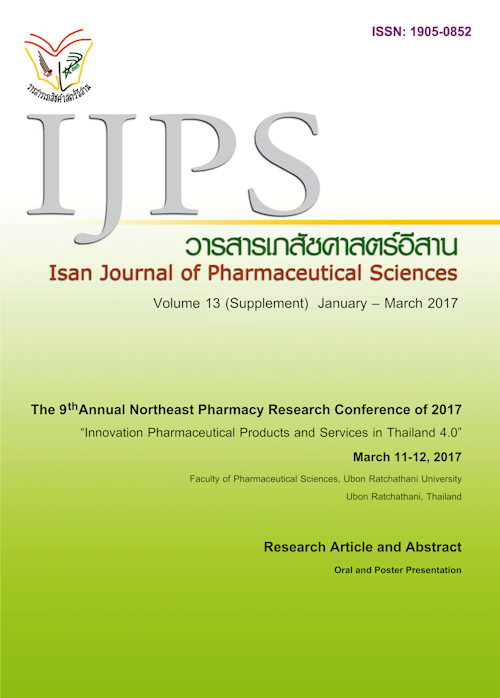Preparation of Curcumin-loaded Polymeric micelles for Oral Colon-Targeted Drug Delivery
Main Article Content
Abstract
Introduction: Curcumin is an anticancer agent to use in chemoprevention and treatment colorectal cancer. However, one problem of curcumin is its low solubility. Polymeric micelles has been designed for entrapment of hydrophobic drugs to improve drug solubility. Thus, this study aimed to investigate entrapment efficiency of curcumin-loaded N-octyl-N,O-succinyl chitosan (OSCS) polymeric micelles, characterization and control drug release at colon targeted site by oral route. Methods: The OSCS micelles were prepared to load curcumin. The physical entrapment methods (dialysis and evaporation) were applied. Curcumin-loaded OSCS micelles were determined loading efficiency, loading capacity, particle size, in vitro cytotoxicity and in vitro drug release. Results: The OSCS micelles were able to load curcumin in the hydrophobic inner core by dialysis and evaporation methods. The curcumin-loaded OSCS micelles by dialysis method showed loading efficiency (22.75±5.54%) and loading capacity (78.42±5.94 μg/mg) higher than evaporation method (loading efficiency 7.80±1.46%; loading capacity 15.59±2.91 μg/mg, respectively). The mean particle sizes of micelles by dialysis method were in the range of 193-260 nm which were smaller than that by evaporation method (310-354 nm). The cytotoxicity of OSCS micelles on Caco-2 cells depended on the concentration of OSCS with the IC50 value of 2.95±0.06 mg/mL. The cumulative release of curcumin from OSCS micelles in simulated gastric fluid (SGF) was about 20%. When pH medium was changed to pH 6.8 (simulated intestinal fluid; SIF) and pH 7.4 (simulated colonic fluid; SCF), the curcumin release was significantly increased (SIF; 50-55%) and (SCF; 60-70%) when compared to curcumin free drug (20%) (p<0.05). Conclusion: These finding supports the potential of these pHsensitive OSCS polymeric micelles and it might be improved solubility of hydrophobic drugs and control drug release at colon targeted site by oral administration.
Article Details
In the case that some parts are used by others The author must Confirm that obtaining permission to use some of the original authors. And must attach evidence That the permission has been included
References
Akl MA, Kartal-Hodzic A, Oksanen T, et al. Factorial design formulation optimization and in vitro characterization of curcumin-loaded PLGA nanoparticles for colon delivery. J Drug Deliv Sci Tec. 2016; 32: 10-20. Bromberg L. Polymeric micelles in oral chemotherapy. J Control Release. 2008; 128(2): 99q112.
Cen L, Hutzen B, Ball S, et al. New structural analogues of curcumin exhibit potent growth suppressive activity in human colorectal carcinoma cells. BMC Cancer. 2009; doi:10.1186/1471-2407-9-99.
Ghaemy M, Ziaei S, Alizadeh R. Synthesis of pH-sensitive amphiphilic pentablock copolymers via combination of ring-opening and atom transfer radical polymerization for drug delivery. Eur Polym J. 2014; 58: 103-114.
Guo L, Chen X, Hu Y, et al. Curcumin inhibits proliferation and induces apoptosis of human colorectal cancer cells by activating the mitochondria apoptotic pathway. Phytother Res. 2013; 27: 422-430.
Kawamori T, Lubet R, Steele VE, et al. Chemopreventive effect of curcumin, a naturally occurring anti-inflamatory agent, during the promotion/progression stages of colon. Cancer Res. 1999; 59: 597-601.
Li Y, Li H, Wei M, et al. pH-Responsive composite based on prednisone-block copolymer micelle intercalated inorganic layered matrix: Structure and in vitro drug release. Chemical Engineering Journal. 2009; 151: 359-366.
Lu Y, Park K. Polymeric micelles and alternative nanonized delivery vehicles for poorly soluble drugs. Int J Pharm.2013; 453(1): 198-214.
Mehanny M, Hathout RM, Geneidi AS, et al. Exploring the use of nanocarrier systems to deliverthe magical molecule; Curcumin and its derivatives. J Control Release. 2016; 225: 1-30.
Mosmann T. Rapid colorimetric assay for cellular growth and survival: application to proliferation and cyto- toxicity assays. J Immunol Methods. 1983; 65: 55q63.
Ngawhirunpat T, Wonglertnirant N, Opanasopit P, et al. Incorporation methods for cholic acid chitosan-g-m PEG self-assembly micellar system containing camptothecin. Colloids Surf B: Biointerfaces. 2009; 74: 253q259.
Sajomsang W, Gonil P, Saesoo S, et al. Synthesis and anticervical cancer activity of novel pH responsive micelles for oral curcumin delivery. Int J Pharm. 2014; 477:261-272.
Sharma D, Soni M, Kumar S, et al. Solubility enhancement-eminent role in poorly soluble drugs. RJPT. 2009; 2(2): 220-224.
Shemesh N, Arber N. Curcumin alone and combination for prevention of colorectal cancer. Curr Colorectal Cancer Rep. 2014; 10: 62-67.
Woraphatphadung T, Sajomsang W, Gonil P, et al. Synthesis and characterization of pH- responsiveN-naphthyl-N, O-succinyl chitosan micelles for oral meloxicam delivery. Carbohydr Polym. 2015; 121: 99q106.
Woraphatphadung T, Sajomsang W, Gonil P, et al. pH-Responsive polymeric micelles based on amphiphilic chitosan derivatives: Effect of hydrophobic cores on oral meloxicam delivery. Int J Pharm. 2016; 497: 150-160.
Yang YQ, Lin WJ, Zhao B, et al. Synthesis and physicochemical characterization of amphiphilic triblock copolymer brush containing pH-sensitive linkage for oral drug delivery. Langmuir. 2012; 28: 8251-8259.


